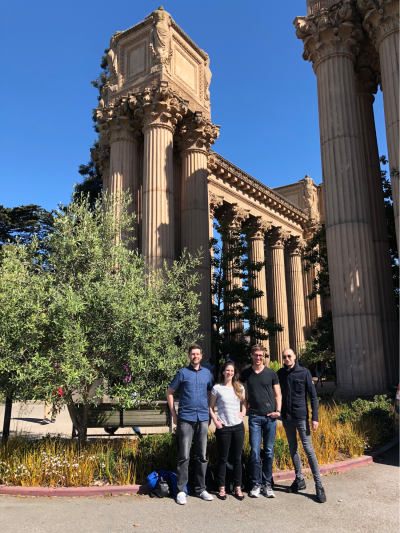QueryCon 2018: our talks and takeaways
Sometimes a conference just gets it right. Good talks, single track, select engaged attendees, and no sales talks. It’s a recipe for success that Kolide got right on its very first try with QueryCon, the first-ever osquery conference.
It’s no secret that we are huge fans of osquery, Facebook’s award-winning open source endpoint detection tool. From when we ported osquery to Windows in 2016 to our launch of our osquery extension repo this year, we’ve been one of the leading contributors to the tool’s development. This is why we were delighted Kolide invited us to participate in QueryCon!
The two-day conference, hosted at the beautiful Palace of the Fine Arts in San Francisco, drew over 120 attendees and 16 speakers. The attendance list was a Who’s Who in Big Tech security; teams from Facebook, Airbnb, Yelp, Atlassian, Adobe, Netflix, Salesforce, and more. It was great to meet face-to-face. We’ve been collaborating with some of these teams on osquery for years. It was also exciting to see the widespread adoption of the technology manifested in person. Though some of the teams attending were there to learn about the tech before deploying, the majority seemed to be committed adopters.
The talks ranged from the big-picture (operational security preparedness by Rob Fry of JASK) to the highly technical (breakdowns of macOS internals by Michael Lynn of Facebook), with consistent levity, epitomized by the brilliantly sulky Ben Hughes of Stripe. Scott Lundgren of Carbon Black gave a report-card-style review of the community from an outsider’s perspective. Longtime osquery evangelist Chris Long of Palantir provided a candid user experience of working with osquery’s audit framework in his organization. It was a well-curated mix of subjects, speakers, and perspectives. They all taught us something new.
What we learned at QueryCon
1. The community is bigger and stronger than we thought
As of this week, osquery’s Slack has 1,703 users. Until the sold-out showing at QueryCon, I never thought to check how many of those users were active; 431 in the last 30 days. 120 of those people made it to QueryCon. Dozens more joined the waitlist.
2. Some users are innovating in very cool ways
We came to QueryCon intent on pushing the community to use osquery in new, innovative ways. Turns out, it didn’t need much pushing. Take the security team at Netflix. They’re using osquery in multiple internal open source projects: Diffy, a digital forensics and incident response (DFIR) tool, and Stethoscope, their security detection and recommendation application. We heard many more examples from many more teams.
3. The community really likes our contributions
Many of the talks mentioned our team and our work. We knew we were contributing significant engineering effort, but we hadn’t truly realized how much others had been benefiting. It felt great to hear that work done for our clients truly advances the whole community.
4. The goals are clear, but the way there is not
We gleaned some clear takeaways that are likely common for a first meetup of a new open source project:
- We need to define and broadcast osquery’s guiding principles;
- We need to solidify some best practices for effective collaboration;
- We need to tackle technical debt.
We didn’t determine how these will get done. Facebook was clear in defining its role in this process. Their small dedicated osquery team will continue to put in the hard work of testing, managing versions, and holding the community to high standards for both written code and community inclusion. However, it’s up to the community to take care of the rest.
What we shared at QueryCon
Osquery Super Features
Speaker: Lauren Pearl
Abstract: In this talk, we reviewed a user feature wishlist gathered from interviews with five Silicon Valley tech teams who use osquery. From these, we identified Super Features – features that would fundamentally improve the value proposition of osquery. We explained how these developments could transform osquery’s power in technical organizations. Finally, we walked through the high-level development plans for making these Super Features a reality.
Link to Video: To be released soon!
Slides: Super Features PDF
The Osquery Extensions Skunkworks Project: Unconventional Uses for Osquery
Speaker: Mike Myers
Abstract: Facebook created osquery with certain guiding principles: don’t pry into users’ data, don’t change the state of the system, don’t create network traffic to third parties. It was originally intended as a read-only information gatherer. For those that didn’t want to play by these rules, there’s the extension interface. We’ve begun experimenting with extensions that don’t align with mainline osquery: integrating with third-party services, writable tables, host-based firewall administration, malware vaccination, and more. We shared some of our lessons-learned on the challenges of using osquery as a control interface.
Link to Video: To be released soon!
Slides: Skunkworks Extensions PDF
Thank you so much!
This was a great first conference for an emerging technology. It awakened community leaders to issues and opportunities and started the conversation of how to push forward. Attendees renewed enthusiasm and commitment to advance and maintain the project.
It’s hard to believe that this was Kolide’s first time hosting such an event. Director Of Operations, Antigoni Sinanis, the lady in charge of the event’s success, has set a high bar for her company to clear next year. We at are already looking forward to round two!
*** This is a Security Bloggers Network syndicated blog from Trail of Bits Blog authored by Lauren Pearl. Read the original post at: https://blog.trailofbits.com/2018/06/08/querycon-2018-our-talks-and-takeaways/








